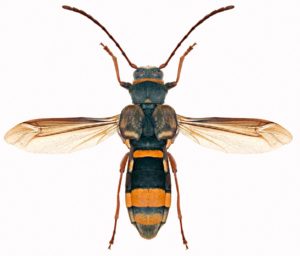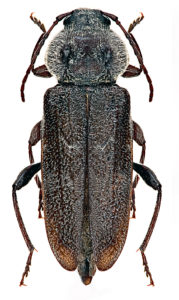Researchers from our National Collection have won the 5th J.O. Westwood Medal for Excellence in Taxonomy by the Royal Entomological Society for their three volume set on longhorn beetle.
The longhorn beetle Mesolita myrmecophila looks like an ant.
As unicorns attest, there is no better way to improve an animal than to give it a horn. Nature has given the longhorn beetles two. (Although strictly speaking they are antennae.)
The world is home to more than 33 000 species of longhorn beetles. Many are quarantine pests, some are dead ringers for totally different insects like ants and wasps, others have drawn life’s short straw: they have short horns!
This longhorn beetle, Hesthesis sp., mimics a wasp. Australian National Insect Collection.
In 2013 Dr Adam Ślipiński and Dr Hermes E. Escalona, researchers from our Australian National Insect Collection completed the first of three volumes that describe and illustrate Australia’s 1400 known species of longhorns.
Their book Australian Longhorn Beetles won the Whitely Medal from the Royal Zoological Society of New South Wales and has just won the pair the 5th J.O. Westwood Medal for Excellence in Taxonomy by the Royal Entomological Society and the Natural History Museum in London. The award is named for John Obadiah Westwood (1805-1893), a British entomologist who helped establish the Royal Entomological Society.
The book provides vital information about the longhorn beetles that exist here in Australia and thus the ones we need to watch out for at our borders. Longhorn beetles are not necessarily easy to recognise, despite their long horns. Before this publication, information about longhorns was hard to find.
Hylotrupes bajulus, the European house borer, is a serious pest in construction timber.
In natural ecosystems, longhorn beetle larvae develop inside living or dead plant tissue, often in damaged or dead trees. This speeds up the decay of rotting wood and helps circulate energy and nutrients. But longhorns cause problems when they develop in timber or in healthy forests and ornamental trees. Many are listed invasive species. They can also spread nematodes (little worms) that can cause diseases in planted trees.
The book was a huge scientific challenge, taking authors Adam and Hermes three years to research and write. They travelled to museums around the world to search for Australian longhorn specimens within their natural history collections. They found around 80 per cent of the specimens needed for the book at home in the Australian National Insect Collection in Canberra, part of CSIRO’s National Research Collections Australia. It’s another example of how our natural history collections are vital for understanding Australia’s biodiversity.
Australian Longhorn Beetles (Coleopetra: Cerambycidae) Volume 1: Introduction and Subfamily Lamiinae was supported by the Department of Agriculture and Water Resources and published by the Australian Biological Resources Study and CSIRO Publishing. Volume 2 covering Subfamily Cerambycinae will be available in June.




